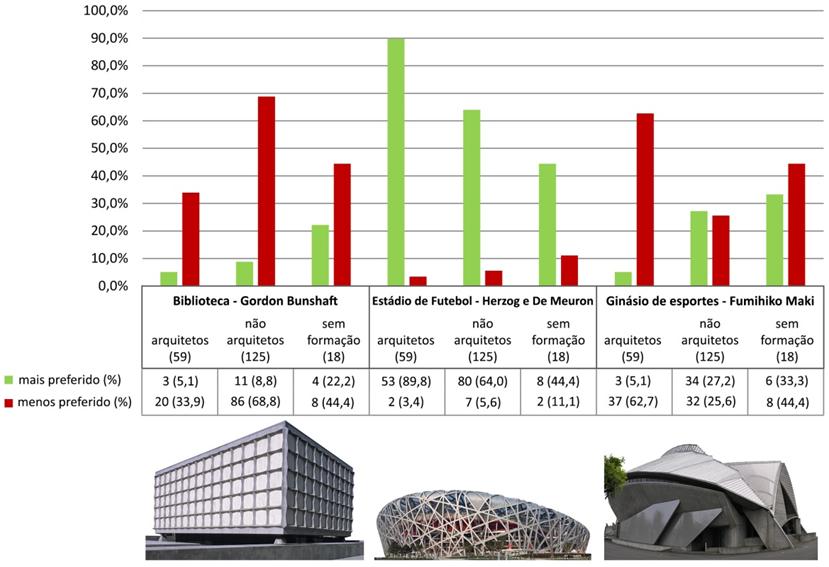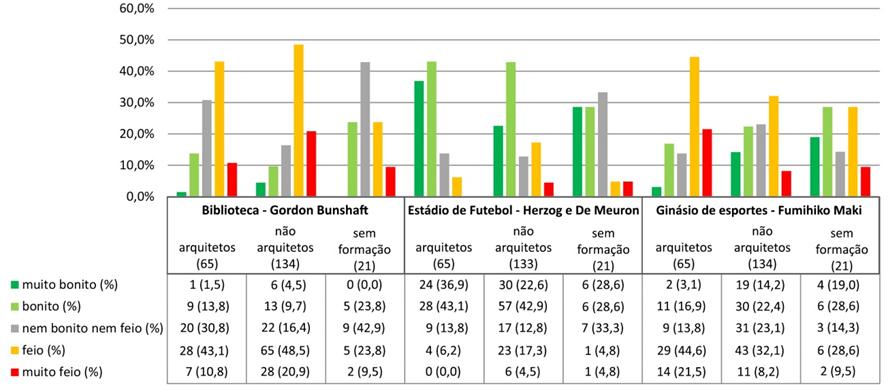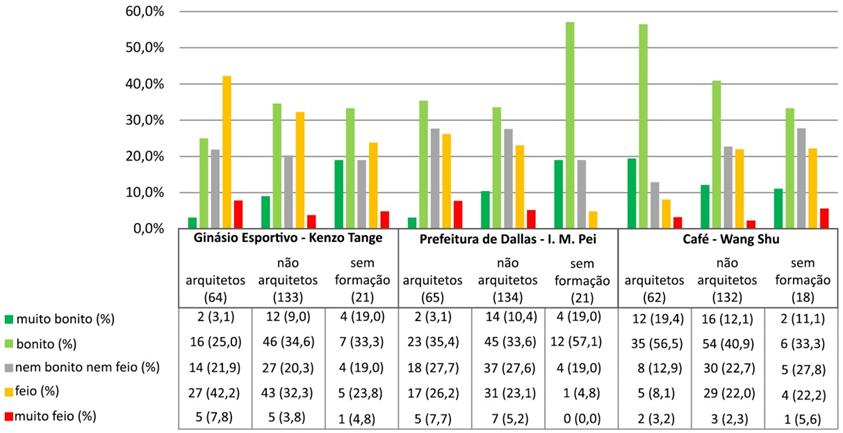Abstract
This aim of this paper is to present an aesthetic evaluation of the architectural composition of 12 projects by architects awarded the world’s most prestigious architecture prize, the Pritzker Architecture Prize, from 1983 to 2012, the identification of the most and least preferred projects and the justifications for such preferences by people with different levels and types of education. The data collection was performed through an online questionnaire in the LimeSurvey program aimed at three groups, totalling 220 respondents, as follows: architects (65); non-architect college graduates (134); persons without a college education (21). Each of the 12 projects was represented in the questionnaire by an edited colour photograph, aiming at removing elements that might affect the aesthetic evaluation of the buildings. Nonparametric statistical tests, such as the Kendall’s W and the Kruskal-Wallis tests, were used for data analysis. The results show, for example, that the projects designed by recipients of the Pritzker Prizewere perceived differently due basically to their different levels of order and visual stimulus, even though there was greater appreciation of the presence of order in the compositions by the respondents who are architects and greater consideration of the existence of visual stimulus by non-architects.
Keywords:
Architectural composition; Aesthetic perception; Pritzker Architecture Prize

 Thumbnail
Thumbnail
 Thumbnail
Thumbnail
 Thumbnail
Thumbnail
 Thumbnail
Thumbnail
 Thumbnail
Thumbnail
 Thumbnail
Thumbnail
 Thumbnail
Thumbnail
 Thumbnail
Thumbnail
 Thumbnail
Thumbnail
 Thumbnail
Thumbnail


 Fontes: 1 -Museu de arte (2009 - construção), Paju-Si, Coréia do Sul, Álvaro Siza (1992 - premiação) http://www.architectural-review.com/buildings/mimesis-museum-by-lvaro-siza-carlos-castanheira-and-jun-saung-kim-paju-book-city-south-korea/8607232.article; 2 -Hotel (2005), Madrid, Espanha, Jean Nouvel (2008) http://visuall.net/2011/02/23/interesting-hotel-projects-hotel-puerta-america-part-i/; e 3 -Cemitério (1971), Módena, Itália, Aldo Rossi (1990) http://ffffound.com/image/96c856602890d73dcc7a0197b8be8f2e5213f553.
Fontes: 1 -Museu de arte (2009 - construção), Paju-Si, Coréia do Sul, Álvaro Siza (1992 - premiação) http://www.architectural-review.com/buildings/mimesis-museum-by-lvaro-siza-carlos-castanheira-and-jun-saung-kim-paju-book-city-south-korea/8607232.article; 2 -Hotel (2005), Madrid, Espanha, Jean Nouvel (2008) http://visuall.net/2011/02/23/interesting-hotel-projects-hotel-puerta-america-part-i/; e 3 -Cemitério (1971), Módena, Itália, Aldo Rossi (1990) http://ffffound.com/image/96c856602890d73dcc7a0197b8be8f2e5213f553.

 Fontes: 1 -Biblioteca (1963), New Haven, EUA, Gordon Bunshaft (1988) http://larryspeck.com/2010/02/19/beinecke-rare-book-and-manuscript-library/; 2 -Estádio de futebol (2008), Beijing, China, Herzog e De Meuron (2001) http://www.bustler.net/index.php/article/herzog_de_meurons_birds_nest_wins_riba_lubetkin_prize; e 3 -Ginásio de esportes (1984), Fujisawa, Japão, Fumihiko Maki (1993)http://www.architravel.com/ architravel/building/ fujisawa-municipal-gymnasium.
Fontes: 1 -Biblioteca (1963), New Haven, EUA, Gordon Bunshaft (1988) http://larryspeck.com/2010/02/19/beinecke-rare-book-and-manuscript-library/; 2 -Estádio de futebol (2008), Beijing, China, Herzog e De Meuron (2001) http://www.bustler.net/index.php/article/herzog_de_meurons_birds_nest_wins_riba_lubetkin_prize; e 3 -Ginásio de esportes (1984), Fujisawa, Japão, Fumihiko Maki (1993)http://www.architravel.com/ architravel/building/ fujisawa-municipal-gymnasium.

 Fontes: 1 -Ginásio esportivo (1964), Takamatsu, Japão, Kenzo Tange (1987)http://www.lifeonsundays.com/post/9622096842/kenzo-tange-kagawa-prefectural-gymnasium-japan; 2 -Prefeitura de Dallas (1978) - EUA, I. M. Pei (1983) http://www.travelsupermarket.com/blog/12-more-sci-fi-film-locations-you-can-actually-visit/; e 3 -Café (2006) Jinhua, China, Wang Shu (2012)http://www.pritzkerprize.com/media/2012_media/imagens-download.
Fontes: 1 -Ginásio esportivo (1964), Takamatsu, Japão, Kenzo Tange (1987)http://www.lifeonsundays.com/post/9622096842/kenzo-tange-kagawa-prefectural-gymnasium-japan; 2 -Prefeitura de Dallas (1978) - EUA, I. M. Pei (1983) http://www.travelsupermarket.com/blog/12-more-sci-fi-film-locations-you-can-actually-visit/; e 3 -Café (2006) Jinhua, China, Wang Shu (2012)http://www.pritzkerprize.com/media/2012_media/imagens-download.

 Fontes: 1 -Ópera de Sydney (1973), Austrália, Jorn Utzon (2003) - Autor (2002); 2 -Biblioteca e museu (1971), Austin, EUA, Gordon Bunshaft (1988)http://www.flickr.com/photos/wallyg/8035778427/; e 3 -Centro de imprensa (1967), Chuo, Japão, Kenzo Tange (1987)http://architecturalmoleskine.blogspot.com.br/2011/10/metabolist-movement.html.
Fontes: 1 -Ópera de Sydney (1973), Austrália, Jorn Utzon (2003) - Autor (2002); 2 -Biblioteca e museu (1971), Austin, EUA, Gordon Bunshaft (1988)http://www.flickr.com/photos/wallyg/8035778427/; e 3 -Centro de imprensa (1967), Chuo, Japão, Kenzo Tange (1987)http://architecturalmoleskine.blogspot.com.br/2011/10/metabolist-movement.html.
